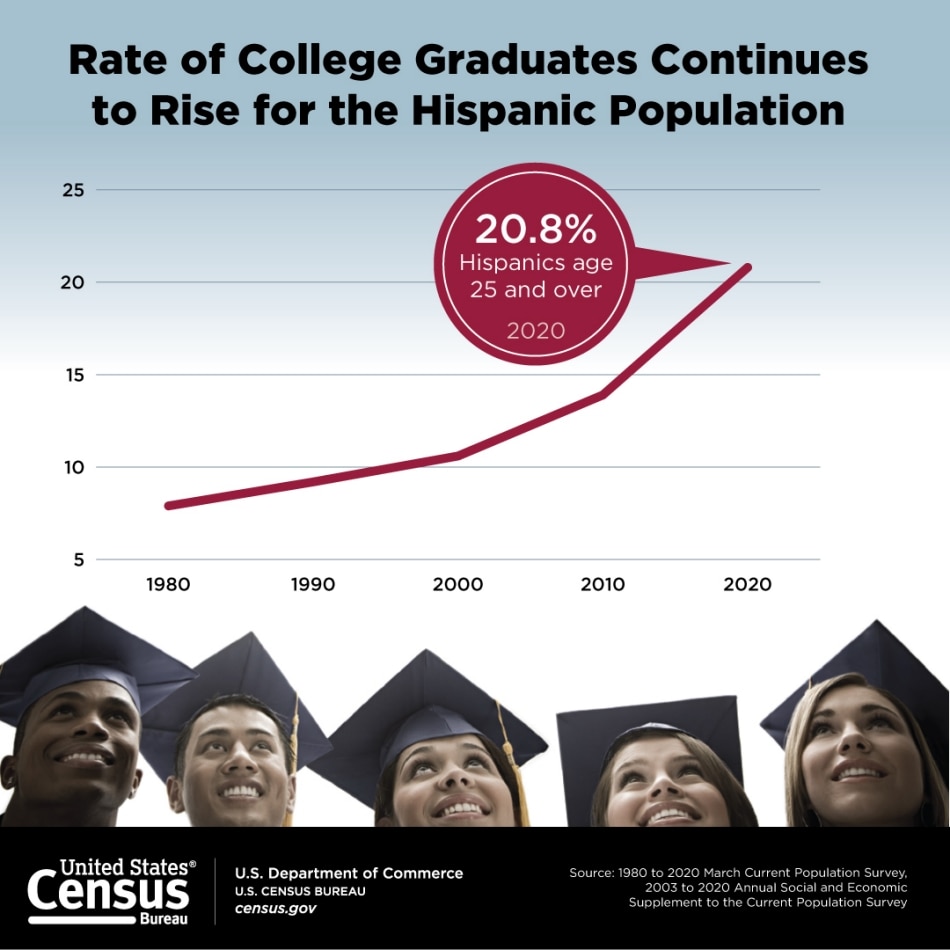Hispanic Heritage Month celebrates the culture and contributions of Americans tracing their roots to Spain, Mexico, Central America, South America and the Spanish-speaking nations of the Caribbean. The observance was born in 1968 when Congress authorized the president to issue an annual proclamation designating National Hispanic Heritage Week. Two decades later, lawmakers expanded it to a monthlong celebration, stretching from September 15 to October 15.
Hispanic Heritage Month — like its shorter precursor — always starts on September 15, a historically significant day marking the independence of five Latin American countries: Costa Rica, El Salvador, Guatemala, Honduras and Nicaragua. The designated period is also a nod to those from Mexico and Chile, which celebrate their independence September 16 and September 18, respectively.
The following facts are available thanks to the public’s invaluable participation in U.S. Census Bureau surveys. We appreciate the information shared by each respondent as we continuously count and measure America’s people, places and economy.
Did You Know?
The Hispanic share of the U.S. population as of April 1, 2020, making people of Hispanic origin the nation’s second largest racial or ethnic group. The Hispanic population grew 2.4 percentage points over the decade from 16.3% in 2010. Source: 2020 Decennial Census
The number of states where the Hispanic population made up the largest racial or ethnic group as of April 1, 2020: New Mexico where the Hispanic population accounted for 47.7%, up from 46.3% in 2010. And California, where the Hispanic population was 39.4%, up from 37.6% of the state’s population a decade earlier.
Source: 2020 Decennial Census
The number of Texas counties where the Hispanic population was the largest racial or ethnic group as of April 1, 2020, up from 64 counties in 2010. Source: 2020 Decennial Census
The share of children (under the age of 18) who were of Hispanic origin as of April 1, 2020, up from 23.1% in 2010. Source: 2020 Decennial Census
Voting
The percentage of the total voting age Hispanic population that voted in the November 2020 election.
Source: Table 4b Voting and Registration in the Election of November 2020
Previous Facts for Features
- FFF: Hispanic Heritage Month 2020
- FFF: Hispanic Heritage Month 2019
- FFF: Hispanic Heritage Month 2018
The following is a list of observances covered by the Census Bureau’s Facts for Features series:
African American History Month (February)
Women’s History Month (March)
Irish American Heritage Month (March)
Asian/Pacific American Heritage Month (May)
The Fourth of July (July 4)
Anniversary of Americans with Disabilities Act (July 26)
Hispanic Heritage Month (Sept. 15-Oct. 15)
Halloween (Oct. 31)
American Indian/Alaska Native Heritage Month (November)
Veterans Day (Nov. 11)
Thanksgiving Day/Holiday Season (November-December)
Note: These data come from a variety of sources and may be subject to sampling variability and other sources of error. We generally release Facts for Features about two months before observances to accommodate magazine production timelines.
Profile America’s Facts for Features provides statistics related to observances and holidays not covered by Stats for Stories. For observances not listed above, visit our Stats for Stories webpage.
Stats for Stories provides links to timely story ideas highlighting newsworthy Census Bureau statistics that relate to current events, observances, holidays and anniversaries. The story ideas are intended to assist the media in story mining and producing content for their audiences. Dates with presidential proclamations are marked with (P).

